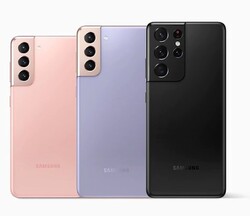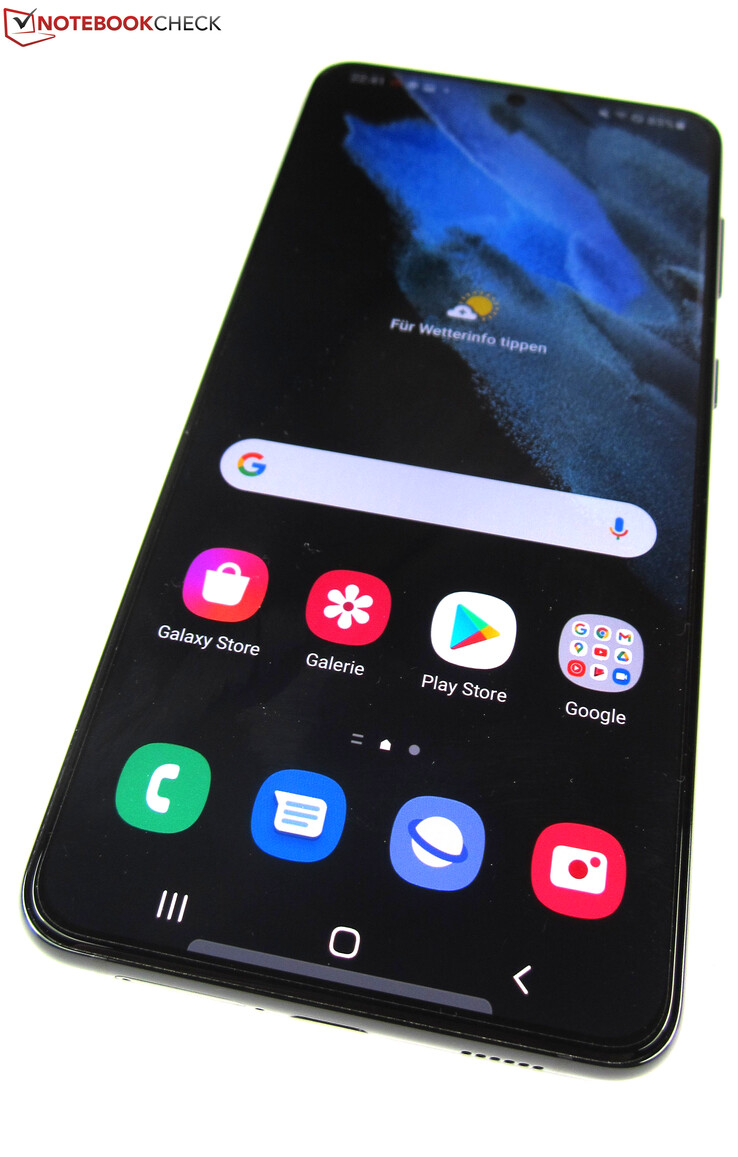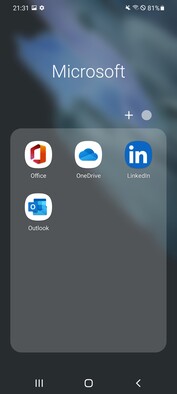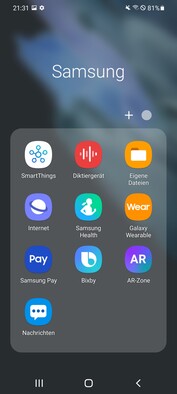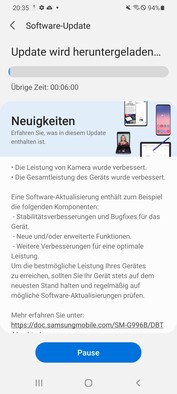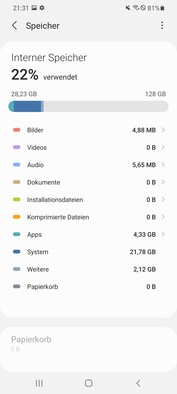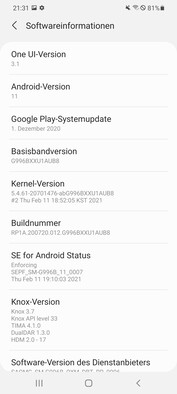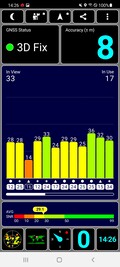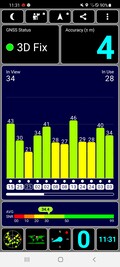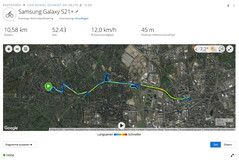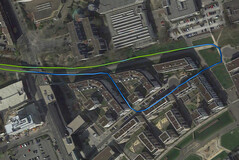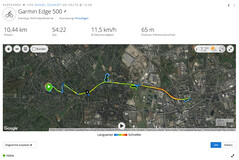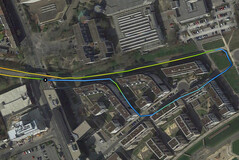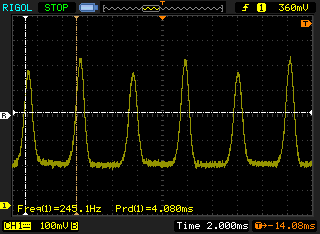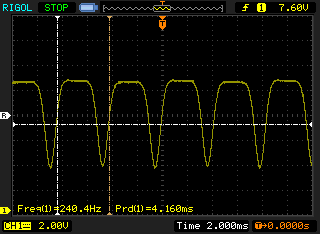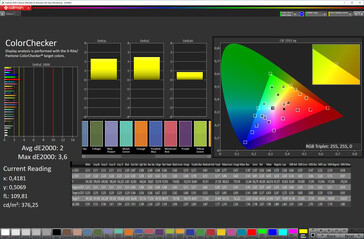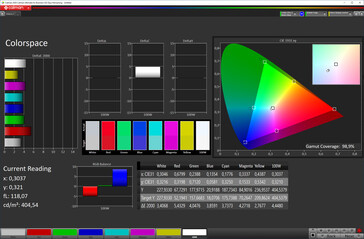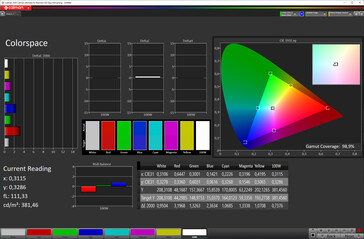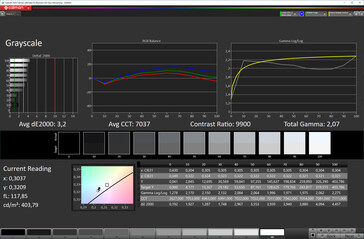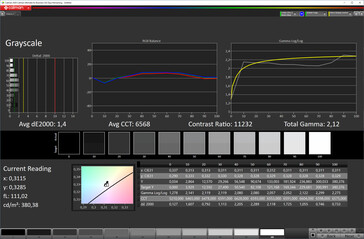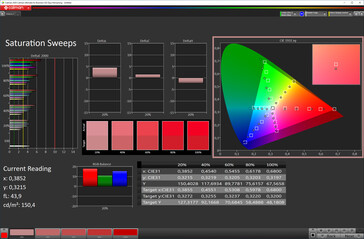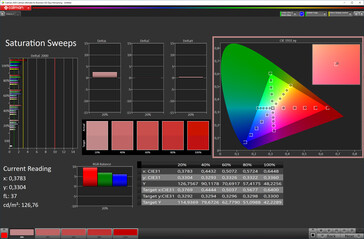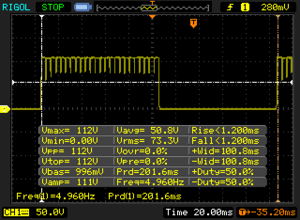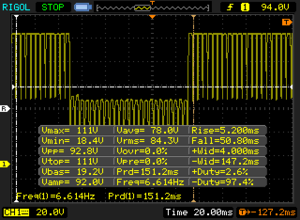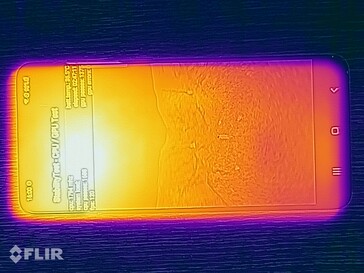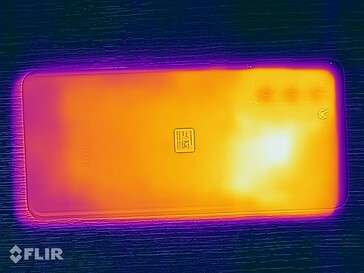Samsung Galaxy S21+ smartphone review: The Galaxy S21 in large
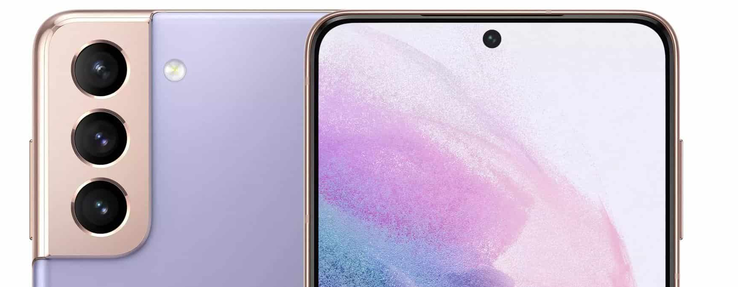
The flagship smartphones of the Galaxy S21 series attract a wide group of buyers. As its most affordable representative, the 6.2-inch Galaxy S21 will probably win the most takers. However, there is also the 6.8-inch Galaxy S21 Ultra, the flagship of the series with the best camera. In between the two is the Galaxy S21+, which also chose the golden middle path in terms of the equipment.
With its large, 6.7-inch display, the Galaxy S21+ is supposed to particularly attract gamers and fans of the series, Samsung says. Correspondingly with its 4800-mAh battery, the smartphone offers the second largest battery of the Galaxy S21 series, and like its siblings also uses a bright AMOLED display and the fast Exynos 2100.
Possible competitors in comparison
Rating | Date | Model | Weight | Drive | Size | Resolution | Price |
|---|---|---|---|---|---|---|---|
| 89.6 % v7 (old) | 02 / 2021 | Samsung Galaxy S21+ Exynos 2100 5G, Mali-G78 MP14 | 200 g | 128 GB UFS 3.1 Flash | 6.70" | 2400x1080 | |
| 88.7 % v7 (old) | 12 / 2020 | Apple iPhone 12 Pro Max A14, A14 Bionic GPU | 228 g | 128 GB NVMe | 6.70" | 2778x1284 | |
| 89.4 % v7 (old) | 04 / 2020 | Huawei P40 Pro Kirin 990 5G, Mali-G76 MP16 | 209 g | 256 GB UFS 3.0 Flash | 6.58" | 2640x1200 | |
| 88.5 % v7 (old) | 04 / 2020 | OnePlus 8 Pro SD 865, Adreno 650 | 199 g | 256 GB UFS 3.0 Flash | 6.78" | 3168x1440 | |
| 87.3 % v7 (old) | 02 / 2021 | Xiaomi Mi 11 SD 888 5G, Adreno 660 | 196 g | 128 GB UFS 3.1 Flash | 6.81" | 3200x1440 | |
| 87.7 % v7 (old) | 04 / 2020 | Samsung Galaxy S20+ Exynos 990, Mali-G77 MP11 | 188 g | 128 GB UFS 3.0 Flash | 6.70" | 3200x1440 |
Case - Glass back as in the Galaxy S21 Ultra
The exteriors of all the IP68-certified Galaxy S21 smartphones are almost identical if you disregard the different form factors. The front looks completely identical, and the Galaxy S21+ also uses a flat AMOLED display with an ultra-sound fingerprint sensor hidden underneath and a selfie camera placed at the top edge of the display.
In contrast to the Galaxy S21, the Galaxy S21+ does not use a plastic back, but like the Galaxy S21 Ultra, also protects its back cover with a layer of Gorilla Glass. In terms of the visual appearance, there is practically no difference between the matte glass back and the plastic back cover of the Galaxy S21, but there is a haptic difference, since the glass back cover has a much higher-quality feel. Both kinds of back cover offer a slight resistance to the fingers, which ensures a secure grip.
The Galaxy S21+ uses the same cameras as the Galaxy S21: a triple lens setup consisting of a 64-MP telephoto lens, a 12-MP wide-angle, and a 12-MP ultra-wide angle lens. The Galaxy S21 Ultra has four cameras.
The Galaxy S21+ is available in "Phantom Black" as in our test unit, as well as "Phantom Silver" and "Phantom Violet." In addition, with "Phantom Gold" and "Phantom Red," there are also two colors that are exclusively available in Samsung's online shop.
Equipment - 8 GB RAM, minimum of 128 GB storage, and a UWB chip
The Galaxy S21+ offers 8 GB of LPDDR5 RAM and two storage models. The smallest model with 128 GB of UFS 3.1 storage officially costs 1049 Euros (~$1271). Because you cannot expand the internal storage due to the lack of a microSD slot, it might be worthwhile to just chose the 256-GB version for a recommended retail price of 1099 Euros (~$1332).
There is really only one important difference in terms of the equipment of the Galaxy S21 smartphones: Only the Galaxy S21+ and the Galaxy S21 Ultra offer an ultra-wideband chip (UWB). Using the UWB chip in combination with the SmartThings app, you can, for example, exactly locate things like keys, bags, or headphones and also control smart home devices.
The USB-C port of the Galaxy S21+ operates at USB 3.2 Gen.1 speed, supports USB OTG, is able to output the display signal via HDMI and DisplayPort adapter, and finally also serves as the audio port, since it lacks a dedicated 3.5-mm audio port. You also have to make do without an IR blaster, radio receiver, or notification LED. The tasks of the latter are taken up by an always-on display. Additional equipment includes Bluetooth 5.0, NFC, ANT+, the Full Camera2 API level, and DRM Widevine L1.
Software - Android 11 and OneUI 3.1 for the Galaxy S21+
The Galaxy S21+ includes Android 11 with Samsung's OneUI 3.1 user interface. Currently, the high-end smartphone is updated diligently. During our test, the firmware of the Galaxy S21+ was updated to version G996BXXU1AUB8, which in addition to performance improvements and bug fixes also included the newest Android security patches (level of February 1st).
The preinstalled apps take up about 28 GB of space, leaving only about 100 GB of available storage in the 128-GB model from the start. In addition to the Google tools, the ROM also includes various Samsung tools, including the Bixby smart assistant and the DeX desktop mode. Several Microsoft apps such as OneDrive and LinkedIn, as well as third-party tools such as Netflix and Spotify, are also included.
Communication and GPS - Fast WLAN and accurate GPS
Like all the Galaxy S21 models, the Galaxy S21+ also supports 5G without mmWave and offers space for two SIM cards. Alternatively, you can also activate an eSIM as a second SIM.
The Galaxy S21+ masters all the current WiFi standards up to WiFi 6E, including VHT160. However, in the 160-MHz range, the smartphone is moving beyond its comfort zone, as our test shows. In connection with our Netgear Nighthawk AX12 reference router, it is much slower in this range, as expected. But at least the transfer rates are relatively stable, although this is only a weak consolation. The low VHT160 starting value when sending is due to the router waking up.
The data transfer using VHT80, however, ranges at a good level. At an average of 855 Mbit/s when receiving, it is even a tad faster than the other high-end competitors in our comparison. On the other hand, at 747 Mbit/s while sending, it is only sufficient for one of the lower places in the middle of the field.
The Galaxy S21+ determines its location using the GPS, GLONASS, BeiDou, and Galileo satellite navigation systems. In our test, it succeeds indoors with an accuracy of up to 8 meters (~26 ft), but it takes a little while. Outdoors on the other hand, the satfix is completed already after a few seconds and also much more accurate at 4 meters (~13 ft).
We evaluate the quality of the navigation skills in practice with a little bike tour where we also take the Garmin Edge 500 for comparison. While the Galaxy S21+ does not record the 10.4-kilometer route (~6.5 miles) quite as accurately as the professional navigation device, its GPS accuracy is absolutely sufficient for everyday usage.
Phone Functions and Voice Quality
The Galaxy S21+ supports VoLTE and VoWiFi and is able to accept two SIM cards. Instead of a physical SIM card, you can also activate an eSIM.
In terms of the voice quality, the smartphone will get a thumbs up overall. Thanks to the efficient noise suppression, the communication of the conversation partners also succeeds flawlessly in louder surroundings. Only the speaker mode of the Samsung is unable to completely convince us, since voices sound fairly tinny and the range of the microphones is not very far.
Cameras - The same, powerful triple-camera system as in the Galaxy S21
The Galaxy S21+ shares the same camera equipment as the Galaxy S21. Both use a triple-camera system, consisting of a 64-MP telephoto lens (1/1.72", F2.0, FOV 76°, OIS), a 12-MP wide-angle lens (1/1.76“, F1.8, FOV 79°, OIS), and a 12-MP ultra-wide angle lens (1/2.55", F2.2, FOV 120°). The 10-MP selfie camera (1/3.24", F2.2, FOV 80°) is also the same and takes good-quality pictures.
Due to the identical camera setup, our verdict for the Galaxy S21 also fits exactly to the Galaxy S21+: The triple camera takes excellent pictures in daylight that convince with strong contrasts and natural-looking colors, even if they appear slightly saturated as is typical for Samsung. In weak light conditions, the night mode helps to still get many details from the scene.
A weak point of the camera is its lack of an optical zoom, which can only be compensated to a limited extent with its up to 30x digital enlargement. As our test scene number 4 shows, the Galaxy S21+ still succeeds in taking quite decent zoom pictures.
Image comparison
Choose a scene and navigate within the first image. One click changes the position on touchscreens. One click on the zoomed-in image opens the original in a new window. The first image shows the scaled photograph of the test device.
Daylight scene 1Daylight scene 2Ultra wideangle5x zoomLowlight SceneIn controlled light conditions (bottom color card), the Samsung captures colors and gray tones fairly accurately, only slightly oversaturating dark green tones. The reproduction of the test chart is sharp almost throughout. While there is some slight brightening at the edges of the image, this also happens in professional cameras. In weak light conditions (top color card, 1 Lux), the color accuracy and sharpness of the detail also suffer, and the test chart looks only blurry.
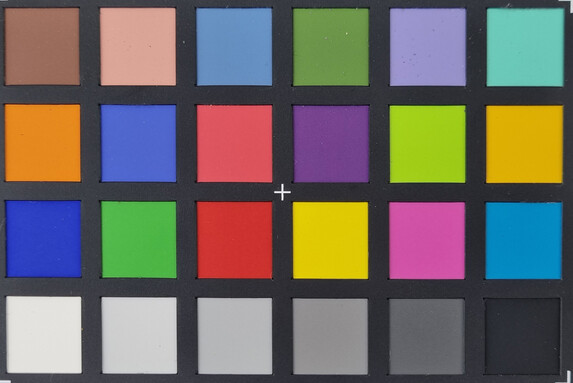

Accessories and Warranty - Charger not included
Samsung ships the Galaxy S21 smartphones without including a charger. The box of the Galaxy S21+ therefore only includes a USB cable (Type-A to Type-C), a SIM tool, a quick-start manual, and a leaflet with warranty information.
Of course you can buy the missing charger in Samsung's online shop. And you can also add other optional accessories such as Bluetooth headphones and USB adapters into your shopping cart at that occasion. However, those who still have another USB-C charger can continue to use it with the Galaxy S21+, which can be charged at up to 25 watts.
The 24-month warranty of the Galaxy S21+ can be expanded by the Care+ warranty package.
Input Devices and Operation - Lightning-fast system speed
The combination of high-end hardware and 120-Hz display ensures that the operation of the Galaxy S21+ remains smooth at all times. The masterful overall impression also includes the ultrasound fingerprint sensor that is integrated into the display and unlocks the smartphone quickly and reliably.
As standard keyboard, the Galaxy S21+ uses the Samsung keyboard, which shows a split keyboard in landscape format. Those who prefer a different keyboard, can change this anytime in the Android settings.
Display - 120-Hz AMOLED panel with only FHD+
The AMOLED display of the Galaxy S21+ has a resolution of 2400 x 1080 pixels, which is the same resolution as the Galaxy S21. However, since that is also significantly smaller at 6.2 inches, it is able to score with the higher pixel density, which is 424 PPI compared to the 393 PPI of the Galaxy S21+.
While the Galaxy S21+ is very far from having a pixelated display with this, it is still a bit disappointing that Samsung would not give the smartphone that is second in the Galaxy S21 hierarchy a higher resolution than the smallest of the models.
However, the display characteristics give no reason for complaint. The panel is able to adjust its refresh rate to the displayed contents within the range between 48 and 120 Hz. Those who want to save some power or don't need a 120-Hz display can switch to a fixed refresh rate of 60 Hz any time.
At an average of 828 cd/m², the AMOLED screen is very bright, and the brightness is also distributed extremely evenly across the screen (97%). In the APL50 measurement, we even get a maximum of 1131 cd/m² from the screen, while it is still 414 cd/m² without the brightness sensor. In the lowest brightness setting, we measure 1.57 cd/m².
Like the Galaxy S21 and the Galaxy S21 Ultra, the Galaxy S21+ is also not without OLED flickering. With minimum panel brightness, the flickering is within the frequency range between 231.5 and 249.1 Hz, and at higher brightness at a constant 240.4 Hz. For sensitive users, those are not good news, since they might notice the low-frequency OLED flickering as annoying.
| |||||||||||||||||||||||||
Brightness Distribution: 97 %
Center on Battery: 814 cd/m²
Contrast: ∞:1 (Black: 0 cd/m²)
ΔE ColorChecker Calman: 2 | ∀{0.5-29.43 Ø4.78}
ΔE Greyscale Calman: 1.4 | ∀{0.09-98 Ø5}
98.9% sRGB (Calman 2D)
Gamma: 2.12
CCT: 6568 K
| Samsung Galaxy S21+ Dynamic AMOLED 2X, 2400x1080, 6.7" | Apple iPhone 12 Pro Max OLED, 2778x1284, 6.7" | Huawei P40 Pro OLED, 2640x1200, 6.6" | OnePlus 8 Pro AMOLED, 3168x1440, 6.8" | Xiaomi Mi 11 LED DotDisplay, 3200x1440, 6.8" | Samsung Galaxy S20+ AMOLED, 3200x1440, 6.7" | |
|---|---|---|---|---|---|---|
| Screen | 14% | -1% | 23% | 5% | -14% | |
| Brightness middle (cd/m²) | 814 | 855 5% | 584 -28% | 796 -2% | 840 3% | 740 -9% |
| Brightness (cd/m²) | 814 | 857 5% | 576 -29% | 779 -4% | 845 4% | 747 -8% |
| Brightness Distribution (%) | 97 | 98 1% | 95 -2% | 94 -3% | 98 1% | 94 -3% |
| Black Level * (cd/m²) | ||||||
| Colorchecker dE 2000 * | 2 | 1.1 45% | 1.1 45% | 0.68 66% | 1.2 40% | 2.6 -30% |
| Colorchecker dE 2000 max. * | 3.6 | 2.51 30% | 2.3 36% | 1.55 57% | 2.7 25% | 4.57 -27% |
| Greyscale dE 2000 * | 1.4 | 1.4 -0% | 1.8 -29% | 1.1 21% | 2 -43% | 1.5 -7% |
| Gamma | 2.12 104% | 2.187 101% | 2.16 102% | 2.237 98% | 2.26 97% | 2.269 97% |
| CCT | 6568 99% | 6337 103% | 6355 102% | 6310 103% | 6492 100% | 6284 103% |
* ... smaller is better
Screen Flickering / PWM (Pulse-Width Modulation)
| Screen flickering / PWM detected | 240.4 Hz | ≤ 99 % brightness setting | |
The display backlight flickers at 240.4 Hz (worst case, e.g., utilizing PWM) Flickering detected at a brightness setting of 99 % and below. There should be no flickering or PWM above this brightness setting. The frequency of 240.4 Hz is relatively low, so sensitive users will likely notice flickering and experience eyestrain at the stated brightness setting and below. In comparison: 53 % of all tested devices do not use PWM to dim the display. If PWM was detected, an average of 8101 (minimum: 5 - maximum: 343500) Hz was measured. | |||
The panel produces the best color reproduction in the "Natural" display mode, which is limited to the sRGB color space, though. The display will produce more vibrant but less accurate colors in the "Vibrant" display mode, which covers the larger DCI-P3 color space.
Display Response Times
| ↔ Response Time Black to White | ||
|---|---|---|
| 2.4 ms ... rise ↗ and fall ↘ combined | ↗ 1.2 ms rise | |
| ↘ 1.2 ms fall | ||
| The screen shows very fast response rates in our tests and should be very well suited for fast-paced gaming. In comparison, all tested devices range from 0.1 (minimum) to 240 (maximum) ms. » 11 % of all devices are better. This means that the measured response time is better than the average of all tested devices (20.2 ms). | ||
| ↔ Response Time 50% Grey to 80% Grey | ||
| 10 ms ... rise ↗ and fall ↘ combined | ↗ 5.2 ms rise | |
| ↘ 4.8 ms fall | ||
| The screen shows good response rates in our tests, but may be too slow for competitive gamers. In comparison, all tested devices range from 0.165 (minimum) to 636 (maximum) ms. » 22 % of all devices are better. This means that the measured response time is better than the average of all tested devices (31.6 ms). | ||
Due to its high brightness reserves, the Galaxy S21+ is very well suited for outdoor usage, displaying the contents easily readable even in direct sunlight.
The viewing angle stability of the display also leaves no reason for complaint. While there is still some bluish or greenish tint when viewing from very steep viewing angles as is typical for AMOLED displays, this has no influence on the readability of the screen.
Performance - The Exynos 2100 is almost as powerful as the Snapdragon 888
The Galaxy S21+ gets its computing power from the Exynos 2100 SoC, which is also used in the Galaxy S21 and the Galaxy S21 Ultra. The octa-core processor is supported by 8 GB of LPDDR5 RAM and the ARM Mali-G78 MP14 GPU.
In other regions such as North America, for example, the Galaxy S21 series is offered with the Snapdragon 888, which is also used by the Xiaomi Mi 11 among the comparison devices. The Exynos 2100 and the Snapdragon 888 compete head-to-head at the high-end level and both currently belong to the fastest Smartphone SoCs.
In the synthetic benchmarks as well as the browser tests, the Snapdragon 888 is slightly ahead overall. However, this does not change anything about the very good system performance of the Galaxy S21+, to which the excellent read and write performance of the UFS 3.1 storage also delivers some contribution.
| PCMark for Android | |
| Work performance score (sort by value) | |
| Samsung Galaxy S21+ | |
| Huawei P40 Pro | |
| OnePlus 8 Pro | |
| Xiaomi Mi 11 | |
| Samsung Galaxy S20+ | |
| Average Samsung Exynos 2100 5G (15718 - 16777, n=3) | |
| Work 2.0 performance score (sort by value) | |
| Samsung Galaxy S21+ | |
| Huawei P40 Pro | |
| OnePlus 8 Pro | |
| Xiaomi Mi 11 | |
| Samsung Galaxy S20+ | |
| Average Samsung Exynos 2100 5G (12255 - 14362, n=3) | |
| AnTuTu v8 - Total Score (sort by value) | |
| Samsung Galaxy S21+ | |
| Apple iPhone 12 Pro Max | |
| Huawei P40 Pro | |
| OnePlus 8 Pro | |
| Xiaomi Mi 11 | |
| Samsung Galaxy S20+ | |
| Average Samsung Exynos 2100 5G (600164 - 633158, n=3) | |
| AImark - Score v2.x (sort by value) | |
| Samsung Galaxy S21+ | |
| Apple iPhone 12 Pro Max | |
| Huawei P40 Pro | |
| Xiaomi Mi 11 | |
| Average Samsung Exynos 2100 5G (226728 - 241222, n=3) | |
| Jetstream 2 - 2.0 Total Score | |
| Apple iPhone 12 Pro Max (Safari 14) | |
| Average of class Smartphone (23.8 - 387, n=149, last 2 years) | |
| Xiaomi Mi 11 (Chrome 88) | |
| Huawei P40 Pro (Huawei Browser 10.1) | |
| Average Samsung Exynos 2100 5G (65.1 - 76.6, n=3) | |
| Samsung Galaxy S21+ (Chrome 88.0.4324.152) | |
| OnePlus 8 Pro (Chrome 80) | |
| Samsung Galaxy S20+ (Chrome 80) | |
| JetStream 1.1 - Total Score | |
| Apple iPhone 12 Pro Max (Safari 14) | |
| Xiaomi Mi 11 (Chrome 88) | |
| Samsung Galaxy S21+ (Chrome 88.0.4324.152) | |
| Huawei P40 Pro (Huawei Browser 10.1) | |
| OnePlus 8 Pro (Chrome 80) | |
| Average Samsung Exynos 2100 5G (98.8 - 127.3, n=3) | |
| Samsung Galaxy S20+ (Chrome 80) | |
| Speedometer 2.0 - Result 2.0 | |
| Average of class Smartphone (15.2 - 643, n=122, last 2 years) | |
| Apple iPhone 12 Pro Max (Safari 14) | |
| Samsung Galaxy S21+ (Chrome 88.0.4324.152) | |
| Average Samsung Exynos 2100 5G (74.1 - 85.8, n=3) | |
| Huawei P40 Pro (Huawei Browser 10.1) | |
| OnePlus 8 Pro (Chome 80) | |
| Samsung Galaxy S20+ (Chome 80) | |
| Xiaomi Mi 11 (Chrome 88) | |
| WebXPRT 3 - Overall | |
| Apple iPhone 12 Pro Max (Safari 14) | |
| Average of class Smartphone (38 - 380, n=31, last 2 years) | |
| Xiaomi Mi 11 (Chrome 88) | |
| Average Samsung Exynos 2100 5G (102 - 132, n=3) | |
| OnePlus 8 Pro (Chrome 80) | |
| Samsung Galaxy S21+ (Chrome 88.0.4324.152) | |
| Samsung Galaxy S20+ (Chrome 80) | |
| Huawei P40 Pro | |
| Octane V2 - Total Score | |
| Apple iPhone 12 Pro Max (Safari 14) | |
| Average of class Smartphone (2228 - 121337, n=197, last 2 years) | |
| Samsung Galaxy S21+ (Chrome 88.0.4324.152) | |
| Xiaomi Mi 11 (Chrome 88) | |
| Average Samsung Exynos 2100 5G (25656 - 28247, n=3) | |
| Huawei P40 Pro (Huawei Browser 10.1) | |
| OnePlus 8 Pro (Chrome 80) | |
| Samsung Galaxy S20+ (Chrome 80) | |
| Mozilla Kraken 1.1 - Total | |
| Samsung Galaxy S20+ (Chrome 80) | |
| OnePlus 8 Pro (Chrome 80) | |
| Huawei P40 Pro (Huawei Browser 10.1) | |
| Average Samsung Exynos 2100 5G (1744 - 1810, n=3) | |
| Samsung Galaxy S21+ (Chrome 88.0.4324.152) | |
| Xiaomi Mi 11 (Chrome 88) | |
| Average of class Smartphone (257 - 28190, n=154, last 2 years) | |
| Apple iPhone 12 Pro Max (Safari 14) | |
* ... smaller is better
| Samsung Galaxy S21+ | Huawei P40 Pro | OnePlus 8 Pro | Xiaomi Mi 11 | Samsung Galaxy S20+ | Average 128 GB UFS 3.1 Flash | Average of class Smartphone | |
|---|---|---|---|---|---|---|---|
| AndroBench 3-5 | -21% | -23% | -9% | -22% | -16% | 33% | |
| Sequential Read 256KB (MB/s) | 1623 | 1775 9% | 1627 0% | 1615 0% | 1603 -1% | 1569 ? -3% | 2228 ? 37% |
| Sequential Write 256KB (MB/s) | 1037 | 395.7 -62% | 730 -30% | 754 -27% | 694 -33% | 768 ? -26% | 1852 ? 79% |
| Random Read 4KB (MB/s) | 309.6 | 228.1 -26% | 208.3 -33% | 278.5 -10% | 199.6 -36% | 244 ? -21% | 296 ? -4% |
| Random Write 4KB (MB/s) | 283.3 | 271.8 -4% | 197.7 -30% | 289.3 2% | 229.8 -19% | 243 ? -14% | 339 ? 20% |
Games - Running smoothly, but still with some limitations
While the Galaxy S21+ with its high-end hardware will of course run all the current games smoothly, it was still unable to convince us to sing its praises, since there could have been more performance at times.
Two examples for this: The "PUBG Mobile" multi-person shooter only runs at a maximum of 30 FPS in the HD setting and we were unsuccessful in trying to change it to the Ultra HD setting. While in "Armajet," the Galaxy S21+ is able to use its 120-Hz-Display to the fullest, this only lasts for a short time. The SoC performance is throttled already right after starting the game, which causes the frame rate to drop continuously.
We determine the gaming frame rates using our Gamebench test tool.
Emissions - Throttling under load
Temperature
At a maximum surface temperature of 38.2 °C (101 °F) in our test, the Galaxy S21+ is always comfortable to hold. However, the smartphone has to apply the internal brakes for this. As the Wild Life stress test from 3DMark shows, the Galaxy throttles its performance considerably under load, so that at the end of the 20 runs of the test, there are only 65.8% of the original performance. We would have liked to repeat these measurements with the GFXBench battery test, but unfortunately it crashed when displaying the results.
| 3DMark - Wild Life Stress Test Stability | |
| Samsung Galaxy S21+ | |
(+) The maximum temperature on the upper side is 38.2 °C / 101 F, compared to the average of 35.2 °C / 95 F, ranging from 21.9 to 247 °C for the class Smartphone.
(+) The bottom heats up to a maximum of 36.6 °C / 98 F, compared to the average of 34 °C / 93 F
(+) In idle usage, the average temperature for the upper side is 28.7 °C / 84 F, compared to the device average of 32.9 °C / 91 F.
Speakers
While the two Dolby Atmos speakers of the Galaxy S21 produce an acceptable sound with balanced mids and highs, it still sounds fairly tinny due to the lack of bass. Headphones and speakers can be connected via USB-C adapter or wirelessly via Bluetooth 5.0. The Samsung supports the Bluetooth SBC, AAC, aptX, and LDAC codecs.
Samsung Galaxy S21+ audio analysis
(+) | speakers can play relatively loud (87.8 dB)
Bass 100 - 315 Hz
(-) | nearly no bass - on average 27.7% lower than median
(±) | linearity of bass is average (11.1% delta to prev. frequency)
Mids 400 - 2000 Hz
(±) | reduced mids - on average 5.3% lower than median
(+) | mids are linear (4.9% delta to prev. frequency)
Highs 2 - 16 kHz
(+) | balanced highs - only 4.2% away from median
(+) | highs are linear (2% delta to prev. frequency)
Overall 100 - 16.000 Hz
(±) | linearity of overall sound is average (18.7% difference to median)
Compared to same class
» 21% of all tested devices in this class were better, 9% similar, 69% worse
» The best had a delta of 11%, average was 35%, worst was 134%
Compared to all devices tested
» 42% of all tested devices were better, 8% similar, 50% worse
» The best had a delta of 4%, average was 24%, worst was 134%
Samsung Galaxy S20+ audio analysis
(+) | speakers can play relatively loud (85.6 dB)
Bass 100 - 315 Hz
(-) | nearly no bass - on average 73.2% lower than median
(+) | bass is linear (0% delta to prev. frequency)
Mids 400 - 2000 Hz
(-) | nearly no mids - on average 73.2% lower than median
(+) | mids are linear (0% delta to prev. frequency)
Highs 2 - 16 kHz
(-) | nearly no highs - on average 73.2% lower than median
(+) | highs are linear (0% delta to prev. frequency)
Overall 100 - 16.000 Hz
(-) | overall sound is not linear (115.8% difference to median)
Compared to same class
» 87% of all tested devices in this class were better, 4% similar, 9% worse
» The best had a delta of 11%, average was 35%, worst was 134%
Compared to all devices tested
» 96% of all tested devices were better, 1% similar, 3% worse
» The best had a delta of 4%, average was 24%, worst was 134%
Battery Life - The second largest battery in the Galaxy S21 series
Power Consumption
Since Samsung does not include a charger with the Galaxy S21+, you have to either buy one or use one that you already have. You can recharge the smartphone at up to 25 watts, or wirelessly via Fast Wireless Charging 2.0 at up to 15 watts. Wireless PowerShare is also supported.
While there is nothing conspicuous in terms of the power consumption, it is slightly above average under load.
| Off / Standby | |
| Idle | |
| Load |
|
Key:
min: | |
| Samsung Galaxy S21+ 4800 mAh | Apple iPhone 12 Pro Max 3687 mAh | Huawei P40 Pro 4200 mAh | OnePlus 8 Pro 4510 mAh | Xiaomi Mi 11 4600 mAh | Samsung Galaxy S20+ 4500 mAh | Average Samsung Exynos 2100 5G | Average of class Smartphone | |
|---|---|---|---|---|---|---|---|---|
| Power Consumption | 6% | 7% | -103% | -46% | -31% | -11% | -16% | |
| Idle Minimum * (Watt) | 0.74 | 0.8 -8% | 0.92 -24% | 2.2 -197% | 1.57 -112% | 1 -35% | 0.967 ? -31% | 0.842 ? -14% |
| Idle Average * (Watt) | 1.27 | 1.5 -18% | 1.41 -11% | 3.3 -160% | 1.92 -51% | 1.7 -34% | 1.357 ? -7% | 1.439 ? -13% |
| Idle Maximum * (Watt) | 1.33 | 1.9 -43% | 1.47 -11% | 3.7 -178% | 1.94 -46% | 2.3 -73% | 1.437 ? -8% | 1.624 ? -22% |
| Load Average * (Watt) | 6.32 | 3.4 46% | 3.35 47% | 5.9 7% | 6.32 -0% | 5.8 8% | 6.42 ? -2% | 7.03 ? -11% |
| Load Maximum * (Watt) | 9.61 | 4.7 51% | 6.37 34% | 8.3 14% | 11.65 -21% | 11.8 -23% | 10.2 ? -6% | 11.3 ? -18% |
* ... smaller is better
Battery Life
Samsung has equipped the Galaxy S21+ with a large 4800-mAh battery, which is the second largest in the Galaxy S21 series. Only in the Galaxy S21 Ultra, it is even larger with 5000 mAh, while the Galaxy S21 has to be content with 4000 mAh.
With its large battery, the Galaxy S21+ delivers a good battery life. Lasting for almost 11 hours in simulated web surfing and significantly more than 19 hours playing videos, the smartphone is able to beat the most current rivals such as the Xiaomi Mi 11. However, it still does not come even close to the Apple iPhone 12 Pro Max, for example. But the battery should still last through a day of intensive usage without any trouble.
| Samsung Galaxy S21+ 4800 mAh | Apple iPhone 12 Pro Max 3687 mAh | Huawei P40 Pro 4200 mAh | OnePlus 8 Pro 4510 mAh | Xiaomi Mi 11 4600 mAh | Samsung Galaxy S20+ 4500 mAh | |
|---|---|---|---|---|---|---|
| Battery runtime | 40% | -9% | 13% | -24% | -1% | |
| Reader / Idle (h) | 29.7 | 43.5 46% | 24.6 -17% | 35.1 18% | 19.1 -36% | 34 14% |
| H.264 (h) | 19.6 | 22.6 15% | 19 -3% | 17.1 -13% | 16.2 -17% | 16.3 -17% |
| WiFi v1.3 (h) | 10.9 | 16 47% | 12.4 14% | 15.4 41% | 8.8 -19% | 13.2 21% |
| Load (h) | 4.7 | 7.1 51% | 3.3 -30% | 4.9 4% | 3.6 -23% | 3.6 -23% |
Pros
Cons
Verdict - Closer to the Galaxy S21 than the Galaxy S21 Ultra
As a "middle" model within the Galaxy S21 lineup, the Galaxy S21+ sits between two chairs. While the flagship smartphone shares all the features with the Galaxy S21, it also has some common characteristics with the Galaxy S21 Ultra top model.
At 6.7 inches, the Galaxy S21+ is almost as large as the Galaxy S21 Ultra and is also not much behind in terms of the battery capacity (4800 compared to 5000 mAh), while the Galaxy S21 has to be content with 4000 mAh. In addition, it shares the glass back cover and the ultra-wideband chip (UWB) with the top model.
But overall, the Galaxy S21+ is closer to the Galaxy S21 than the Galaxy S21 Ultra: the camera equipment is the same, just like the RAM and storage sizes, but unfortunately also the display resolution. 2400 x 1080 pixel are a bit meager for a 6.7-inch flagship.
Just like its Galaxy S21 siblings, the Galaxy S21+ also offers excellent performance, but aside from the larger form factor and battery, there is practically no difference to the Galaxy S21, which costs 200 Euros (~$242) less.
Not only in terms of form factor and equipment but also with its price, the Galaxy S21+ falls between the Galaxy S21 (849 Euros, ~$1029 recommended retail price) and the Galaxy S21 Ultra (starting from 1249 Euros, ~$1514). What differentiates it from the Galaxy S21 is basically only the larger display, the larger battery, and the ultra-wideband chip. The 200 Euro (~$242) premium that you have to pay for the Galaxy S21 Ultra appear more justified, since it offers the best display, the best camera, and the largest battery.
If you ignore the elegant and considerably more modern design of the Galaxy S21+, the differences to the predecessor are very limited, so those who already have the Galaxy S20+ don't necessarily have to reach for the successor.
Price and Availability
Samsung Galaxy S21+
- 08/31/2022 v7 (old)
Manuel Masiero




